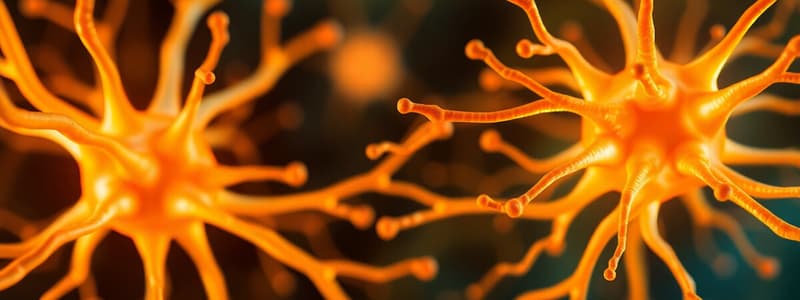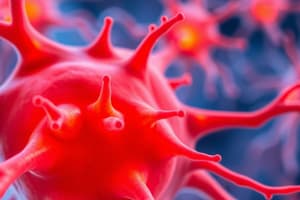Podcast
Questions and Answers
What role does the presynaptic neuron play in neurotransmission?
What role does the presynaptic neuron play in neurotransmission?
- It receives signals from the postsynaptic neuron.
- It facilitates the reuptake of neurotransmitters.
- It generates action potentials in the postsynaptic neuron.
- It releases neurotransmitters into the synaptic cleft. (correct)
What terminates the activity of a neurotransmitter at a synapse?
What terminates the activity of a neurotransmitter at a synapse?
- Continuous release of neurotransmitters.
- Breakdown by enzymes or reuptake by the presynaptic neuron. (correct)
- Binding to the presynaptic membrane.
- Increased action potential frequency.
Which of the following is true regarding the action of neurotransmitters?
Which of the following is true regarding the action of neurotransmitters?
- They bind to receptors and trigger a response in the postsynaptic neuron. (correct)
- They are stored in the synaptic cleft until needed.
- They create action potentials in the presynaptic neuron.
- They can only inhibit neuronal activity.
Which component of the central nervous system provides cushioning for the brain and spinal cord?
Which component of the central nervous system provides cushioning for the brain and spinal cord?
What is the primary effect of serotonin in the brain?
What is the primary effect of serotonin in the brain?
What is the first step in the nerve impulse transmission process?
What is the first step in the nerve impulse transmission process?
Which part of the nervous system is primarily responsible for involuntary control over heart rate?
Which part of the nervous system is primarily responsible for involuntary control over heart rate?
Which component of the reflex arc directly carries nerve impulses from sensory neurons to the central nervous system?
Which component of the reflex arc directly carries nerve impulses from sensory neurons to the central nervous system?
What is the role of efferent nerves in the nervous system?
What is the role of efferent nerves in the nervous system?
How does the sympathetic nervous system achieve efficiency in responding to stimuli?
How does the sympathetic nervous system achieve efficiency in responding to stimuli?
What is a primary function of the parasympathetic nervous system?
What is a primary function of the parasympathetic nervous system?
What structure serves as the gap between neurons where neurotransmitters are released?
What structure serves as the gap between neurons where neurotransmitters are released?
In the nerve impulse transmission pathway, which structure is responsible for receiving the impulse after it crosses the synapse?
In the nerve impulse transmission pathway, which structure is responsible for receiving the impulse after it crosses the synapse?
What happens at the synapse during nerve impulse transmission?
What happens at the synapse during nerve impulse transmission?
Which component is essential for increasing the speed of impulse travel along the axon?
Which component is essential for increasing the speed of impulse travel along the axon?
In a two-neuron reflex arc, what types of neurons are involved?
In a two-neuron reflex arc, what types of neurons are involved?
What defines the phase of depolarization in a neuron?
What defines the phase of depolarization in a neuron?
What primarily causes the change in membrane potential during an action potential?
What primarily causes the change in membrane potential during an action potential?
What role do Nodes of Ranvier play in nerve impulse conduction?
What role do Nodes of Ranvier play in nerve impulse conduction?
In a three-neuron reflex arc, which additional component is included besides the sensory and motor neurons?
In a three-neuron reflex arc, which additional component is included besides the sensory and motor neurons?
What triggers the next segment of a neuron to depolarize?
What triggers the next segment of a neuron to depolarize?
Flashcards are hidden until you start studying
Study Notes
Synapse
- A synapse is a point where "electrical" information is converted to "chemical" information
- Occurs at the end of dendrites and axons
- It is the junction between two neurons or a neuron and another cell
Synapse Components
- Presynaptic neuron: Neuron sending the signal
- Postsynaptic neuron: Neuron receiving the signal
- Neurotransmitter: Chemical messenger released from the presynaptic neuron
- Synaptic vesicle: Small sac containing neurotransmitters
- Synaptic cleft: Gap between the presynaptic and postsynaptic neurons
Neurotransmitters
- Chemicals released from presynaptic axons
- Bind to receptors on the postsynaptic membrane triggering an action potential in the receiving neuron
- Activity is terminated by breakdown (enzymes) or reuptake (presynaptic neuron)
- Over 30 different neurotransmitters have been identified
Neurotransmitter Imbalances: Antidepressants
- Serotonin is a neurotransmitter related to mood
- Depression is thought to be linked to a decrease in serotonin levels
Central Nervous System
- Composed of the brain and spinal cord
Protection of the Central Nervous System (CNS)
- Bone: Skull protects the brain, vertebral column protects the spinal cord
- Membranes (meninges): Dura mater, pia mater, and arachnoid mater surround the brain and spinal cord
- Cerebrospinal fluid: Fills the meninges, circulates between ventricles and the blood
Nerve Impulses
- Action potential: Propagation of a charge differential down the axon
- Myelin sheaths increase the speed of action potential travel
- Depolarization: Shift in the charge of a neuron from negative to positive
- Ion flow occurs at the Nodes of Ranvier
Nerves and Synapses
- Carry information between the central nervous system (CNS) and peripheral nervous system (PNS)
- Nerve impulse transmission: Stimulus --> dendrite --> cell body --> axon --> synapse --> dendrite --> cell body --> axon --> synapse --> muscle
Reflex Arc and Action Potential
- Afferent nerves carry impulses from sensory stimuli to the CNS
- Efferent nerves carry impulses from the CNS to motor neurons, leading to movement
Autonomic Nervous System (Involuntary)
- Responsible for controlling involuntary functions
- Controls cardiac muscle tissue, smooth muscle tissue, and glandular epithelial tissue
- Divided into sympathetic and parasympathetic divisions
Sympathetic Nervous System (SNS)
- Prepares the body for stress (threat, injury)
- Increases heart rate and muscle contraction
- Controlled by spinal nerves
- One spinal nerve can activate several secondary branches, maximizing efficiency
Parasympathetic Nervous System (PNS)
- Maintains homeostasis
- Slows down bodily functions - decreases heart rate, relaxes muscles
- Controlled by cranial nerves
- Important for regulating breathing, digestion, and other involuntary functions
Studying That Suits You
Use AI to generate personalized quizzes and flashcards to suit your learning preferences.




